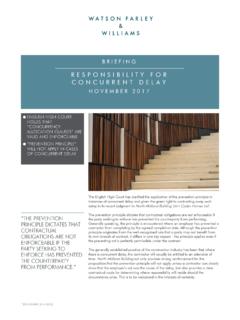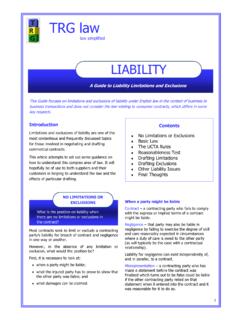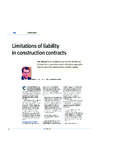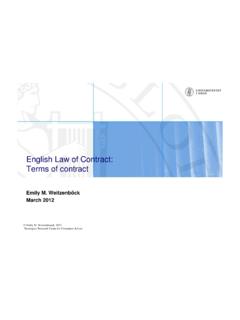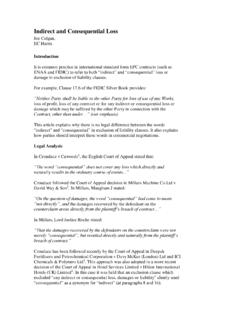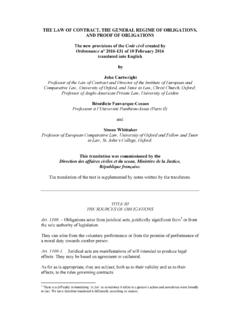Transcription of RESERVATION OF RIGHTS (“ROR”) LETTERS
1 INTRODUCTION As the global economy struggles to recover from the 2008 crash, ship finance lenders remain beset by ship owner loan defaults. Whilst loan agreements invariably entitle lenders to rely on an Event of Default to terminate their lending relationship promptly and to enforce their security, this is, for most, an option of absolute last resort. The occurrence of an Event of Default is much more commonly the start of a long process in which the lender investigates whether its borrower can remedy the default or, if not, whether the loan can viably be rescheduled or restructured or otherwise the default can at least be mitigated by an orderly disposal of assets or some other form of wind-down of the borrower s business.
2 During this process, whilst working with its customer to find a solution, a lender will usually want to preserve its RIGHTS to rely on all defaults, past, continuing and future, both to retain the whip-hand in discussions with its borrower and to be able to move quickly should no solution be found. This briefing note explores the extent to which lenders can successfully reserve their RIGHTS and what protection lenders may obtain by sending ROR LETTERS . If an Event of Default occurs, does the lender have to do anything?
3 The starting point is that a lender may rely on an Event of Default at any time after it occurs. The loan agreement will not usually require the lender to act within a fixed or reasonable time. If the lender simply does nothing, the starting point is that the borrower cannot rely on the lender s inactivity to object to the lender MARITIME BRIEFING RESERVATION OF RIGHTS ( ROR ) LETTERSDECEMBER 2014 THIS BRIEFING NOTE EXPLORES THE EXTENT TO WHICH LENDERS CAN SUCCESSFULLY RESERVE THEIR RIGHTS AND WHAT PROTECTION LENDERS MAY OBTAIN BY SENDING ROR LETTERS IF AN EVENT OF DEFAULT OCCURS, DOES THE LENDER HAVE TO DO ANYTHING?
4 ROR LETTERS : WHAT PURPOSE DO THEY SERVE? WAIVER CLAUSES DRAFTING ROR LETTERS 1 Watson Farley & Williams acting at a later date on the Event of Default11. Why might a lender not want to take action in response to a default? Where the lender sees no prospect of the default being remedied quickly or at all, and is reluctant to enforce its security, it is not uncommon for lenders to do nothing. That may be because the lender is over-secured, and is not too troubled by a default which the lender perceives to be short-term.
5 Alternatively, where the lender is under-secured, the lender may not be ready to hasten on a substantial loan write off. Sometimes the default may just be one of many that occur during restructuring discussions, where to notify yet another default seems to be somewhat of a distraction. A lender s inactivity must be viewed together with the lender s other conduct. Ship finance lenders typically maintain their customers operating accounts. Thus they see the ship s earning come in to those accounts and must authorise payments from those accounts to meet operating expenses (OPEX).
6 They also often have to decide what sums are to be moved to a retention account to facilitate future debt service, whilst allowing the ship owner sufficient sums to meet OPEX. So, whether or not a lender formally notifies a default, it is likely, and almost certain in the case of a payment default, that this will result in a dialogue which may, in turn, lead the borrower to suppose that the lender will not rely on or will at least suspend its strict RIGHTS arising under the loan agreement. A lender, by doing as little as to arrange a meeting to discuss the borrower s default, risks leading the borrower to suppose that the lender is forbearing from taking action pending that meeting.
7 Certainly where the course of negotiations between lender and borrower carries the implication that the lender will not enforce its RIGHTS whilst the negotiation continues, the lender may, in such circumstances, be estopped from relying on its RIGHTS , unless the lender has first made clear that the lender expects the default to be remedied, and gives borrower a reasonable opportunity to do so2. The same implication may also arise where the lender has failed to act on a default for a very considerable period of time, especially if the lender has, in the meantime, acted inconsistently with an intention to rely on the default, for example by permitting funds which could be used to remedy a payment default to be used instead to meet OPEX.
8 In such event, for the lender to rely on a continuing default, such as an unremedied payment default, the lender may easily recover the position by giving the borrower a reasonable further opportunity to remedy the default. In most cases, an opportunity of as little as one working day will suffice. In the case of an historic default, the lender will probably not be able to rely on the default retrospectively once cured. So, in the case of a payment default, as soon as the borrower has paid the sums due, the lender, once it has accepted the payment, cannot then rely on the Event of Default that has since been cured3.
9 It can therefore be seen that once a lender embarks on any kind of discussion with its customer following an Event of Default, equitable principles risk intervening to prevent the lender from exercising its RIGHTS , unless the lender has made clear that it has not given up or suspended its right to rely on them. For this reason, ship finance lenders are well aware of the importance of notifying defaults and reserving their RIGHTS to rely on them. Indeed, the issuance of ROR LETTERS by lenders has become so routine and frequent that they may dominate a lender s 1 See Chitty on Contracts, 31st Ed.
10 , para 3092 and the cases referred to in the footnotes to that para. 2 Under the principle in Hughes v- Metropolitan Railway (1877) 2 App. cas. 439. 3 Whether a payment has been accepted it a question of fact, but once a lender has processed a payment and applied it to the relevant account without protest, it will undoubtedly have been accepted see The Laconia [1977] 1 Lloyd s Rep. 315 (HL). RESERVATION of RIGHTS ( ROR ) Letters2correspondence with a defaulting customer. This raises the question what purpose ROR LETTERS serve and whether they can be shortened.




